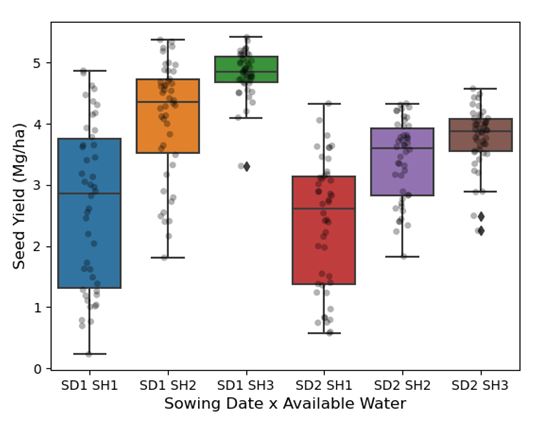Use of the CSM-CROPGRO-peanut model in Argentina to estimate optimal sowing date and crop water productivity under different soil water content
DOI:
https://doi.org/10.52755/sas.v3i2.188Palavras-chave:
Arachis hypogaea L., Drought, Crop evapotranspiration, Crop transpirationResumo
Almost 99% of Argentine peanut production is localized in Córdoba province, mainly under a rainfed regime. In this region, rainfall fluctuations can lead to droughts of varying severity. The peanut optimum sowing date can be determined using a crop growth model and historical climatic data, estimating the impact of drought on yields. This simulation aimed to identify optimum sowing dates of peanuts growing under three available water contents at seeding, in Córdoba. A secondary objective was to determine the responses of yield and dry matter to crop evapotranspiration and transpiration for the different treatments. CROPGRO-Peanut model seasonal analysis was carried out. For this, weather data from 1973 to 2019 at Manfredi Experimental Station, and crop coefficients of cultivar ASEM 485 INTA were used. The soil employed was a silty loam Typic Haplustoll. Treatments were: three available water contents up to 150 cm deep (30%, 60%, and 100%) at seeding, and two sowing dates (21/Oct. and 9/Dec.). The optimal planting date, determined by CSM-CROPGRO-peanut for Córdoba is influenced by the soil water content at sowing. In both sowing dates, a higher median seed yield and a smaller interquartile difference were determined when soil water content increased. In each soil moisture, the late sowing date presented lower median values but less variability. The number of bad years was 15 when the initial moisture content was 30%, regardless of the sowing date. The remaining planting date-initial water combinations did not determine bad years. Increases in early/late planting ranged from 19/12 36/31 and 46/42 good years when increasing moisture content. The highest water content at planting is associated with luxury consumption. Dry matter production/yield best fits a linear relationship when compared to transpiration rather than crop evapotranspiration. This behavior is accentuated in the early planting date.
Downloads

Downloads
Publicado
Como Citar
Edição
Seção
Licença
Copyright (c) 2022 Gustavo Ovando, Ricardo Javier Haro

Este trabalho está licenciado sob uma licença Creative Commons Attribution-NonCommercial-ShareAlike 4.0 International License.
Autores concordam com os seguintes termos:
a) Os autores mantêm os direitos autorais e concedem à revista o direito de primeira publicação, com o trabalho simultaneamente licenciado sob a LicençaAttribution-NonCommercial-ShareAlike 4.0 International, que permite o compartilhamento do trabalho com reconhecimento da autoria e publicação inicial na Revista SAS. A licença permite o uso, a distribuição e a reprodução irrestrita, em qualquer meio, desde que devidamente citada a fonte. Essa licença permite também que outros remixem, adaptem e criem a partir do seu trabalho para fins não comerciais, desde que atribuam a você o devido crédito e que licenciem as novas criações sob termos idênticos.
b) Não cabe aos autores compensação financeira a qualquer título, por artigos ou resenhas publicados na South American Sciences.
c) Os conceitos expressos nos artigos publicados na South American Sciences são de inteira responsabilidade de seus autores.








